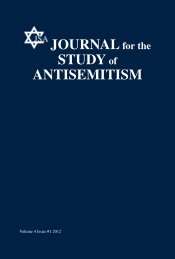JOURNALfor the STUDYof ANTISEMITISM
JOURNALfor the STUDYof ANTISEMITISM
JOURNALfor the STUDYof ANTISEMITISM
Create successful ePaper yourself
Turn your PDF publications into a flip-book with our unique Google optimized e-Paper software.
2011] MEXICO IN A REGION UNDER CHANGE 29<br />
countries in <strong>the</strong> region. Its current Jewish population totals 39,500. 2 In a<br />
country with a population of 112, 336,538 people, <strong>the</strong> Jewish community<br />
has a visible presence that outreaches its numbers. 3<br />
When analyzing antisemitism, one has to take into account that concern<br />
has been voiced about an excessive focus on it as <strong>the</strong> primary characteristic<br />
of <strong>the</strong> region, warning against a simplistic and reductionist<br />
identification of Latin America with intolerance and anti-Jewish expression.<br />
This concern has led to calls for balance, demanding more nuanced distinctions<br />
between different times, places, and modalities of expression.<br />
Certainly, <strong>the</strong> interfacing between national, regional, and global<br />
antisemitism, its inner differentiation, and contemporary expressions have<br />
to be considered. Diffuse and latent prejudices, veiled and structural, as<br />
well as those rejected in <strong>the</strong> official semantics but evident in <strong>the</strong> rhetoric of<br />
individuals and of collective sectors are part of new, complex societies both<br />
in Latin America and elsewhere. The historical course of this rhetoric,<br />
which does not necessarily translate into discriminatory practices, needs to<br />
be contextualized within each country’s political culture and status of<br />
human rights. Understanding its manifestations emerges as a sine qua non<br />
when attempting to account for <strong>the</strong> actual extent of antisemitic danger as<br />
opposed to <strong>the</strong> symbolic violence of its expressions in <strong>the</strong> media.<br />
Antisemitism can be seen as a phenomenon that to a large extent is produced<br />
and reproduced discursively. 4<br />
Both at <strong>the</strong> level of attitudes, stereotypes, and prejudices on <strong>the</strong> one<br />
hand, and at <strong>the</strong> behavioral level manifest in acts, practices, and actual normative<br />
arrangement on <strong>the</strong> o<strong>the</strong>r, antisemitism had and has a broad impact<br />
on <strong>the</strong> representation of <strong>the</strong> “o<strong>the</strong>r.” It is precisely this dimension that<br />
acquires new relevance amid <strong>the</strong> changing trends of cultures that historically<br />
had expressed serious difficulties facing heterogeneity. This question<br />
is directly related to <strong>the</strong> dimension of <strong>the</strong> public sphere as <strong>the</strong> space for<br />
constructing shared civic-national foundations for <strong>the</strong> legitimate expression<br />
of difference.<br />
2. Sergio DellaPergola, “¿Cuántos somos hoy? Investigación y narrativa sobre<br />
población judía en América Latina,” Ibid.:305-340.<br />
3. 2010 Total Population, “México en Cifras” (Mexico in Numbers). INEGI<br />
(Mexican National Institute for Statistics and Geography), http://<br />
www.inegi.org.mx/sistemas/mexicocifras/MexicoCifras.aspx?e=0&m=0&sec=M.<br />
4. See Martin Reisigl and Ruth Wodak, Discourse and Discrimination: Rhetoric<br />
of Racism and Antisemitism (New York: Routledge), 2001.














